A Chinese woman sewing
Primary tabs
Who: As the postcard's title says, it shows a Chinese woman, sitting on a stool on the pavement, busy sewing.
She offered a mobile repair service, using the shoulder pole leaning on the wall behind her to carry her material, thread, needles, etc., from place to place. I've seen other postcards showing sewing women, so they must have been a common sight in Hong Kong at the time, but I haven't found much information about the ladies. There's a brief mention in Betty Steel's diary, describing a scene from the 1930s:
"A Chinese street is crowded, colourful and noisy. Shops are open fronted. Boards are put up over the front late at night, and taken down early in the morning - the Chinese never seem to sleep! Outside the shops are hanging banners and signs inscribed with elegant Chinese characters. From the upper floors, washing hangs out to dry on long poles.
On the pavement, women in black jackets and trousers sit on stools sewing. A scribe sits at a table on the pavement writing a letter for someone, using a brush and Chinese ink to make the beautiful characters."
I also found part two of an article in the Daily Press from 1933, subtitled "Women coolies, amahs, sew women and beggars", but after mentioning the "sew women" in the heading it doesn't give any further detail about them. If you know of any other descriptions of these women's work and lives, please could you let us know in the comments below?
Where: There aren't any obvious landmarks in the scene, but both the houses in the background have signs that are legible, so they might help. Here's the one on the left:
I don't find any exact matches for H. A. Jooma Jusab in Google, though Jooma and Jusab both appear in results that show they're surnames from India. I'm not sure if this sign is for one person's name, or the name of a company owned by Messrs Jooma & Jusab. Let's try searches in the other usual places.
- Carl Smith Cards:
- Jooma: Khamisa Jooma was a draper in Hong Kong in the 1880s
- Jusab: No matches
- Online newspapers:
- Jooma: Khamisa Jooma again in 1883
- Jusab: No matches
- HKGRO, Gwulo:
- No matches
Nothing very helpful there, so how about the sign on the right building?
It is in worse condition than the first sign, but I think the top line reads 'Currimbhoy & Co. Ltd'. It looks as though there may be a third line in English too, though most of it is hidden behind a plant. Do the Chinese characters have anything to add, or are they just the Chinese versions of these names?
A search for Currimbhoy returns plenty of matches, including a Wikipedia entry for Sir Fazalbhoy Currimbhoy Ebrahim:
"[He] was a mid 19th century Gujarati Khoja businessman of the Nizari Ismaili faith based in Bombay. He is credited with founding E. Pabaney & Co, a family held trading and ship owning company whose trading interests extended as far as the Arabian peninsula, the African coast and China.
The Khoja family was based in Bombay, and had been active in Canton (the capital city of the Guangdong Province in southern China) before the Opium War. They had a virtual monopoly on India's overseas merchandising. They continued to maintain a considerable stake in the opium trade through E. Pabaney & Co, with branch offices springing up in Hong Kong and Shanghai during the latter half of the 19th century."
Currimbhoy & Co. Ltd were definitely connected to the 'E. Pabaney & Co' shown above, as the 1925 edition of The Comacrib Directory of China has an entry that shows both names:
"CurrImbhoy & Co., Ltd.— (E. Pabaney)— Exporters & Importers—P.O. Box 312— Tel. Add.: 373—Cable Add.: “Triumph”— 41 Wyndham Street. M. Dhunji, Mgr."
As far as I can tell from the old maps, number 41 Wyndham Street has always had an open passageway to the left of it. In this photo there's the H. A. Jooma Jusab house on the left, so I don't think that number 41 can be the building we're looking for.
Moving ahead to 1933, that year's Juror's List shows the company has a new manager, a Mr Goolamhusain Sheriff Bhimjee, who gave his address as 52 Wyndham Street. Number 52 is in sight of number 41 but on the opposite side of the road. It has a building on its left side, so that fits too. (The modern building at 52 Wyndham Street site is called New India House, suggesting another possible link to Currimbhoy & Co. I tried ordering details of the lot of land from the Government's IRIS system, hoping to see a list of its owners. but the information returned only went back as far as 1971 - I've rarely used IRIS, so maybe I ordered the wrong document?)
Next I turned to Gwulo's map of places to see if we had any photos of the area. This one isn't very sharp, but the buildings furthest away from the camera, just left of the centre of the photo, should be in the same terrace as numbers 50 and 52.
The buildings have the same curved bays, each with two arched windows, as the buildings in the main photo. Unless we get any better ideas, I'll say the main photo shows numbers 50 and 52, Wyndham Street.
When: Sometimes the back of the postcard offers clues to help narrow down the date, but not in this case. If any readers have a mailed copy of this postcard in their collection, please could you let us know the date of the postmark?
We already noted how scruffy the Currimbhoy & Co. sign looks compared to its neighbour's. The buildings are in very different condition too.
Currimbhoy's building is missing its entrance gate, and its hallway is dark and in need of a fresh coat of paint. Then look at the state of their windows, which are missing several panes of glass! It looks as though Currimboy and Co. are no longer here, and that the building has been left empty for some time.
The 1937 copy of the Directory & Chronicle has no entry for Currimbhoy & Co. (see page A569), and they don't appear in the next Juror's List we have online, the list for 1941. It suggests the company moved out sometime in the mid-1930s, and that this photo was taken in the mid- to late-1930s. I'll guess it was taken around 1938.
What: There are two signs painted on the wall.
I recognise the sign on the right as one that shows there's a Fire Hydrant nearby. The numbers tell the fireman that the hydrant is connected to a 4-inch diameter water pipe, and that the hydrant is 8 feet away from the front of the sign.
But does anyone know what the oval sign with the number 583 was for? Was it simply the identifying number of the fire hydrant, or was it for something else completely?
There was lots of guesswork for this week's photo. If you can add any better information or correct any mistakes, please let us know in the comments below.
Gwulo photo ID: A560
Further reading: You'll find lots more old photos and their stories in my books, Old Hong Kong Photos and the Tales They Tell, Volumes one, two, and three.
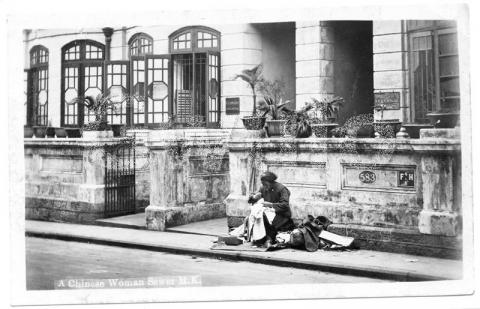
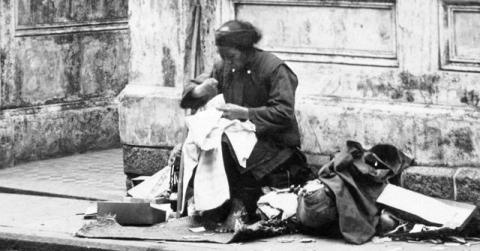
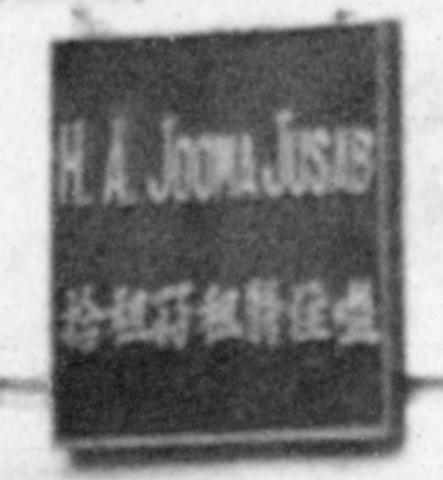
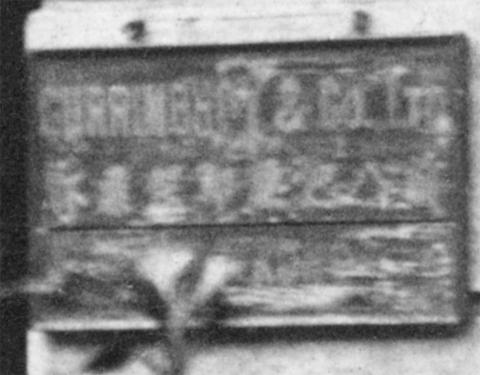
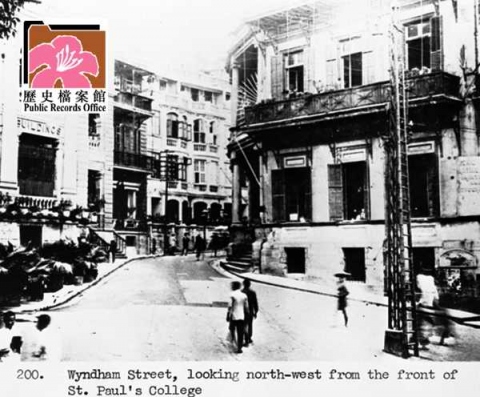
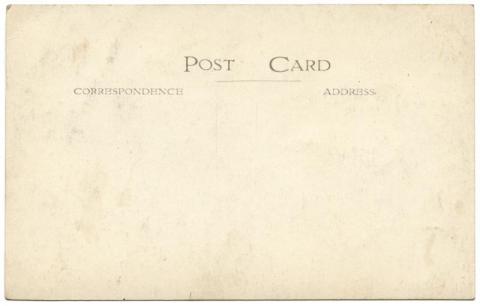
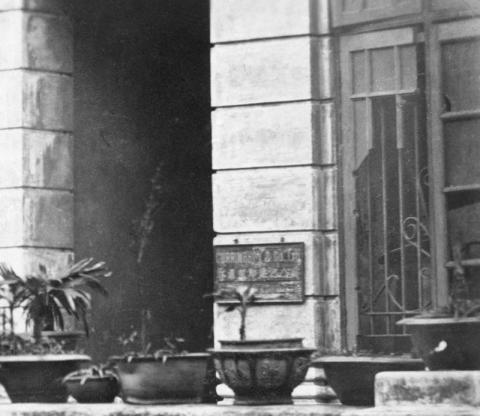
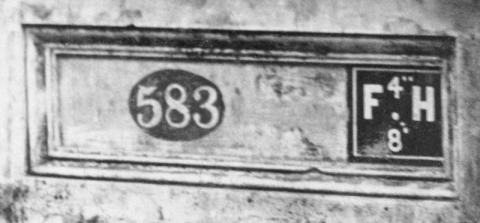


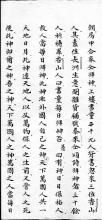
Comments
Re: Signs Painted on the Wall
I think the left side of the wall shows the identification number of the underground hydrant on Wyndham Street. From the Fire Brigade Report of 1938, it is noted there were 205 pedestal fire hydrants and 734 underground hydrants on Hong Kong Island.
Reading information supplied here from the U. K. on fire hydrant plates, it would be reasonable to suggest that standardized hydrant markings showing the distance information to the underground hydrant would have appeared from the late 1930s. Thus, the postcard period looks about right.
Wyndham Street c1920s
Definitely Wyndham street, Here is a photo looking down Wyndham street from what is now the Centrium stairway. I had previously dated it 1920s but that was pretty much a guess - it does seem to have been taken at a similar time to the Woman Sewing photo
Sewing ladies
Sewing ladies did not disappear. A couple used come around the flats at Kings Park in the 1950s repairing clothes, tablecloths, etc. One even did a good job of 'invisible mending'.
A Chinese woman sewing
Here's a bit more info about itinerant Chinese seamstresses who worked on pavements in Hong Kong...
A photo (Ed02-086) on Historical Photographs of China is captioned in the original photograph album:
"I think this is a street sew amah at work. They do all sorts of mending. They'll mend a ladder the full length of a silk stocking for about 1d or 1½d !! / 1933 / April".
"1d" = one penny , which is a half of a new penny (current British currency). "1½d" (i.e. 1.5d) is less than 1p (British currency). The double exclamation marks suggest that the seamstress charged very little.
FH01-159 is captioned in the original photo album: "Sew-Sew".
HR01-062 is captioned in the original photo album: "Sow Sow Women".
Re: Original Photo
I had viewed the original photo from quite some time ago. Without much to go on, I had guessed the photo had been taken in the late 1920s together with a bunch of other photos showing itinerant vendors and others plying their trades.
The original photo postcard does crop up for sale from time to time at auction sites. But I have yet to see a defintive postal date.
The remark about the photo date being from the late 1930s is from the fire hydrant markings on the wall. Have yet to verify this piece of information on standardized fire hydrant markings at the time, which may well consume a fair bit of time.
H.A. Jooma Jasab
i think the sign of H.A. Jooma Jasab is having chinese character: "嗌住翳租孖租拾" which H=嗌住, A=翳, Jooma=租孖 & Jasab=租拾。
Thanks for all the replies
Thanks for all the replies with extra photos and information. We've got the location fixed, but it looks as though the date may still need to be adjusted. One firm date is that these buildings were completed in 1919, see https://gwulo.com/node/50730, so we must be later than that.
A Chinese woman sewing
There’s another photo of a street seamstress reproduced in a children’s book ‘Beside the Bamboo’ by John Macgowan (London Missionary Society, 1914), captioned as follows: ‘AN ITINERANT MENDER OF CLOTHES. She carries a basket with her, with odds and ends that she can use to give any work-out garments a new lease of life. She is a good gossip and takes the place of the daily newspaper with her thrilling stories of what is going on in the town. She is content to earn threepence or fourpence a day’. Not quite sure about her being ‘content’, but love the ‘daily newspaper’ service!
Sewing Ladies